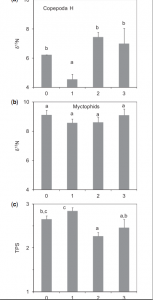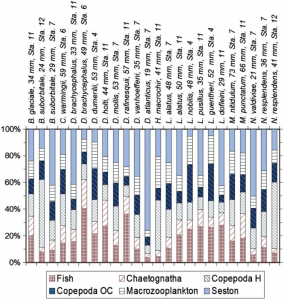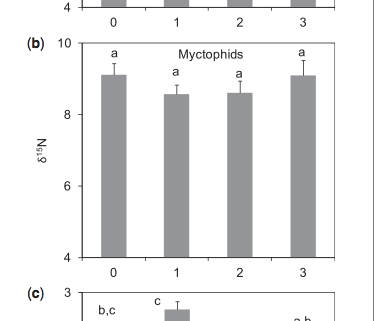Trophic position of laternfishes (Pisces Myctophidae) of the tropical and equatorial Atlantic estimated using stable isotopes
By Molly Rickles, SRC intern
Lanternfish are small mesopelagic fish that make up the most important component of the daily vertical migrating fish community. During the day, they occupy the mesopelagic layers, and at night they travel to the surface for feeding. These fish are important because they play a vital role in the carbon cycle, by transporting zooplankton from the surface layers to the deep ocean. In this study, the authors used stable isotope analysis to determine the exact trophic position of the lanternfish. This was done by sampling plankton and fish across the tropical and equatorial portion of the Atlantic. Then, the isotopic values for the species at each station were determined using the varying distribution of carbon and nitrogen at the depth that they were caught. The abundance of stable isotopes was reported as 13C or 15N. Then, the trophic level was determined using 3 separate methods- TPA (additive model), TEF (total enrichment factor, and TPA (decreasing isotopic enrichment with an increase in trophic level). For this, the calanoid copepod was used as a baseline, which has a trophic position of 2 and is listed as a primary consumer. This was done to get a better idea of the exact trophic level of each individual species (Figure 2).

Figure 2: These charts show the average 15N values for copepods and myctophids along with their trophic positions. The results are separated by the zones they were collected in. Source: Stable Isotopes Approach to Infer the Feeding Habit and Trophic Position of Freshwater Fishes in Tropical Lakes. (2016). Iranica journal of energy and environment. doi:10.5829/idosi.ijee.2016.07.02.14
Through water sampling, researchers determined that there was a chlorophyll maximum at 30-70m, which is important since the lanternfish mostly feed on zooplankton. In addition, the oxygen minimum zone was observed at 200-600m. The results showed that there was no difference in stable isotope analysis of plankton and seston groups among the different zones that were sampled. However, values for myctophids (laternfish) varied between different species and zones. In addition, between the 3 methods of estimating trophic position, it was determined that myctophids have a trophic position between 1.5-2, but sampled organisms ranged from 2-4, meaning that they occupy lower trophic levels. They were found to mainly consume herbivorous copepods and crustacean microzooplankton. It was also found that copepods made up the largest portion of the laternfish’s diet, at 38% (Figure 1).

Figure 1: This chart shows the organisms that make up the diets of the most abundant myctophids. Source: Stable Isotopes Approach to Infer the Feeding Habit and Trophic Position of Freshwater Fishes in Tropical Lakes. (2016). Iranica journal of energy and environment. doi:10.5829/idosi.ijee.2016.07.02.14
This study was important because it showed that stable isotope analysis is more effective at determining trophic position and diet than stomach sampling, which normally gives limited data. The researchers also proved that myctophids occupy a key position in the food web for the transfer of nutrients from plankton to upper trophic levels. This is important because it had not been previously identified that myctophids played an important role in the trophic structure of many marine ecosystems due to their feeding habits and trophic position.
Works cited
Stable Isotopes Approach to Infer the Feeding Habit and Trophic Position of Freshwater Fishes in Tropical Lakes. (2016). Iranica journal of energy and environment. doi:10.5829/idosi.ijee.2016.07.02.14




Leave a Reply
Want to join the discussion?Feel free to contribute!